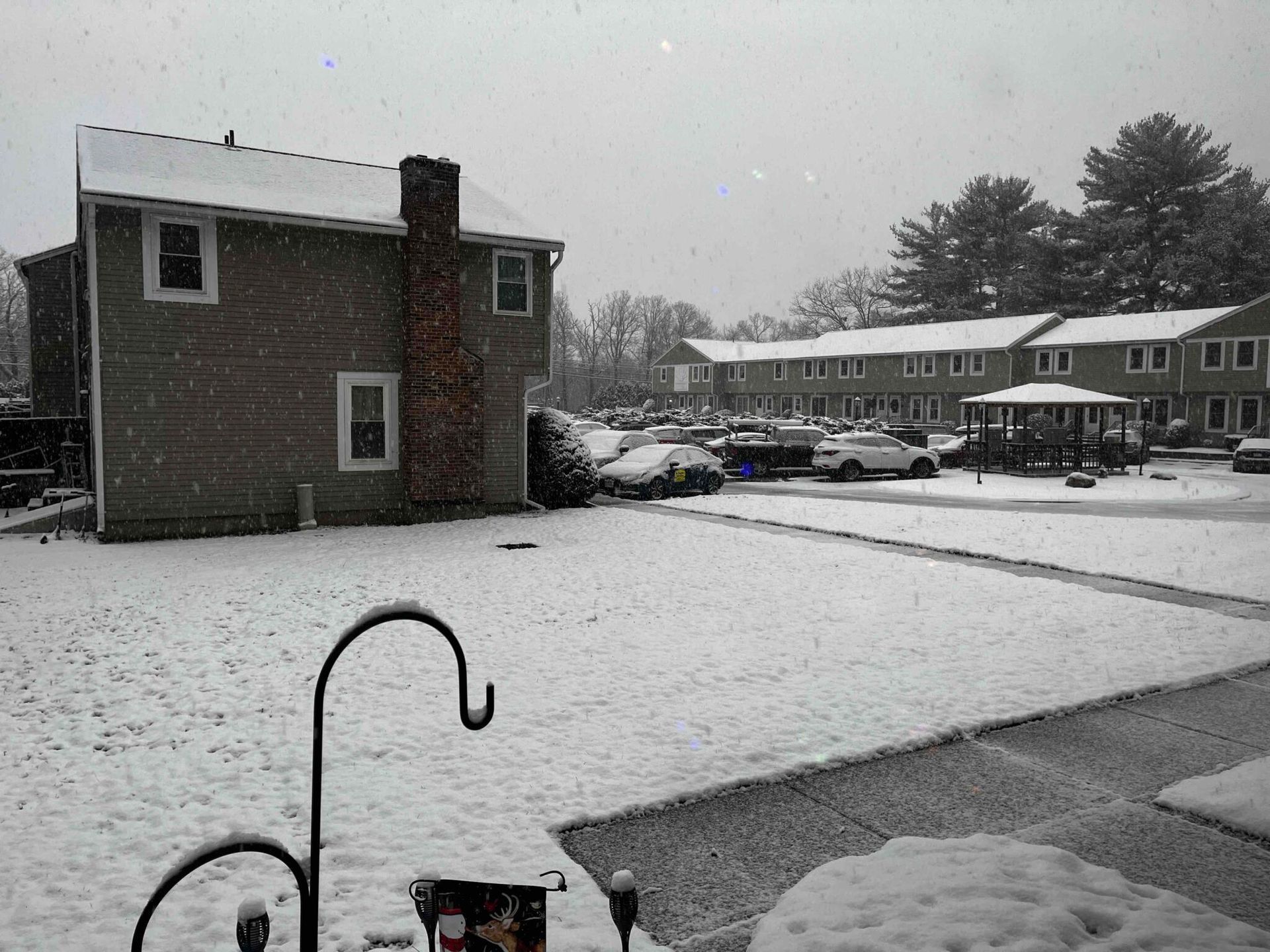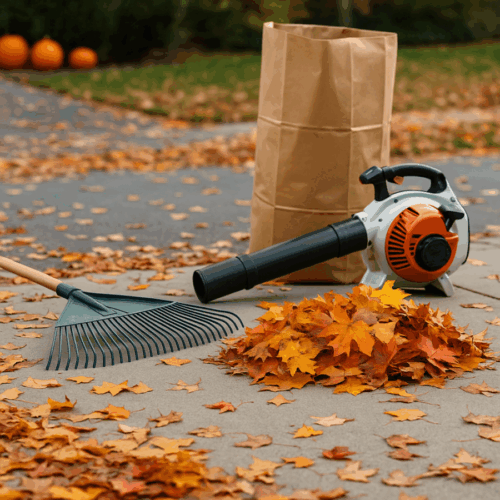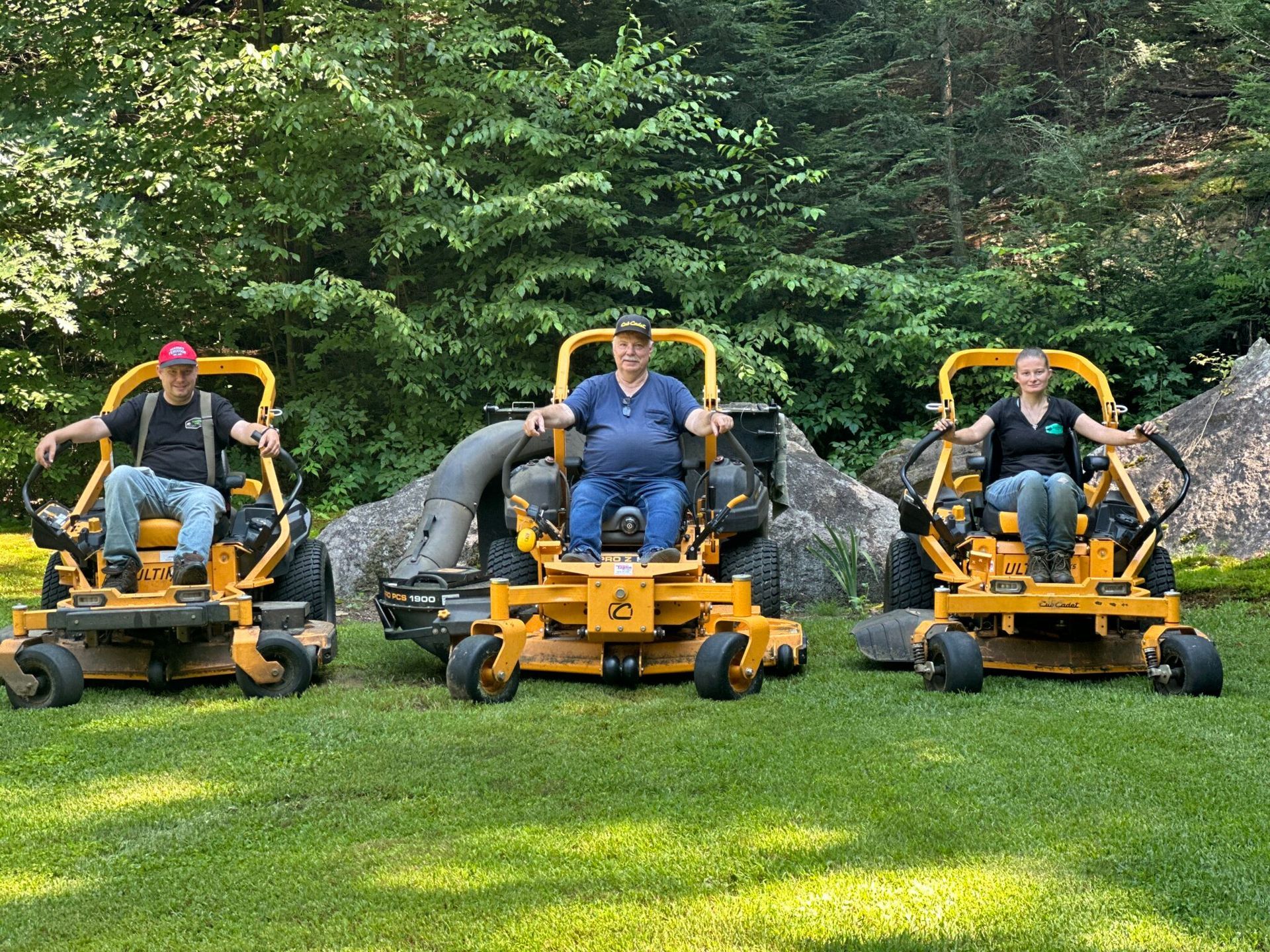How Much Does Professional Lawn Care Cost in 2025?
How Much Does Professional Lawn Care Cost in 2025?
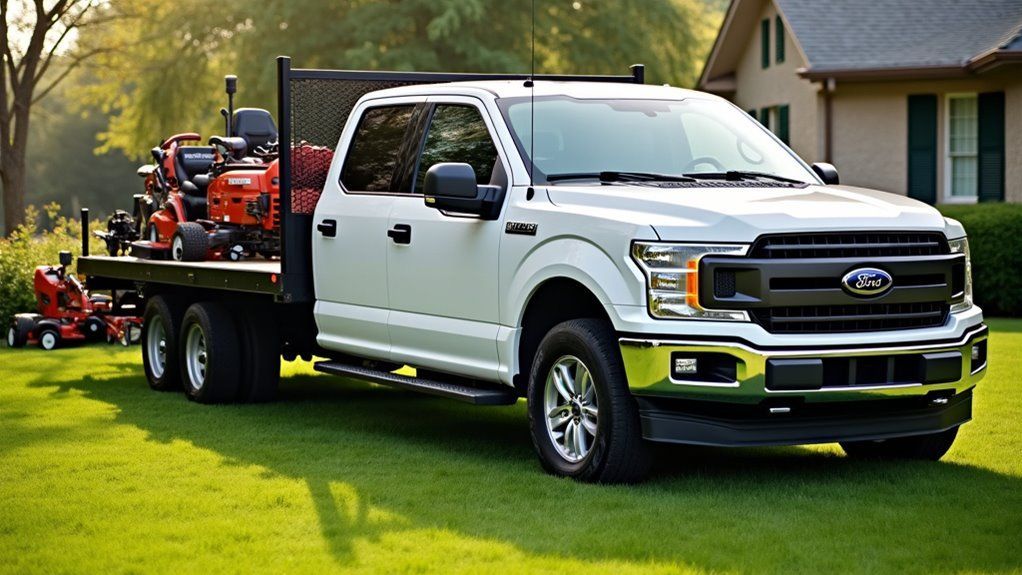
You’ll find professional lawn care costs in 2025 ranging from $65 to $85 per visit for quarter-acre properties, with basic services including mowing, edging, and cleanup. Year-round maintenance packages average $2,800-$3,500 annually, while seasonal plans run $1,200-$1,800. Your actual costs will vary based on location, with Northeast prices 30-40% higher than Southwest rates. Understanding the factors that influence pricing can help you secure the best value for your investment.
Basic Lawn Care Service Packages and Pricing

Basic lawn care service packages in 2025 start at $65-85 per visit for an average quarter-acre residential property. Most standard lawn care packages include mowing, edging, and blowing of hard surfaces. You’ll typically receive service every 7-14 days during peak growing season, with adjustments based on your climate and grass type.
Additional service inclusions you’ll find in basic packages are trimming around obstacles, spot-treating visible weeds, and seasonal cleanup of leaves and debris. Many providers now offer flexible scheduling through mobile apps, letting you customize visit frequency. While prices have increased 12% since 2023 due to rising labor and fuel costs, you’ll still find competitive rates by comparing local providers. Most companies also offer discounts for prepaid seasonal contracts or monthly subscription plans.
Factors That Influence Professional Lawn Care Rates
The size of your property and its geographical location will greatly impact your lawn care costs in 2025, with urban areas typically commanding higher rates than rural regions. You’ll find that extensive service types, such as fertilization, weed control, and seasonal cleanups, naturally cost more than basic mowing packages. Your chosen service frequency also plays a vital role in pricing, as weekly maintenance programs often offer better value per visit compared to one-time or sporadic services.
Property Size and Location
Professional lawn care rates vary considerably based on your property’s physical attributes and geographical setting. Your lawn size directly impacts service costs, with most companies charging between $45 and $80 per visit for properties under 5,000 square feet, while larger yards can cost $150+ per service. You’ll typically pay premium rates in urban areas due to higher operating costs and increased demand.
Geographic climate also plays an essential role in pricing. If you live in regions with longer growing seasons, like Florida or Texas, you’ll need more frequent maintenance visits compared to properties in cooler climates. Furthermore, your property’s terrain complexity, obstacles (trees, flower beds, and hardscaping), and accessibility affect service rates. Companies often charge extra for yards with steep slopes or limited access points.
Beyond property characteristics, your selected service package and maintenance schedule heavily influence lawn care costs. Most companies offer tiered lawn care frequency options ranging from basic mowing to extensive maintenance programs. You’ll find the sweet spot between cost and care level depends on your lawn’s specific needs.
| Service Type | Frequency | Avg. Cost/Visit |
|---|---|---|
| Basic Mowing | Weekly | $45-65 |
| Full Service | Bi-weekly | $85-125 |
| Premium Care | Monthly | $150-200 |
| Seasonal Prep | Quarterly | $250-350 |
Service packages typically bundle multiple treatments like fertilization, weed control, and pest management. The more frequent your service visits and the more extensive your chosen package, the higher your total investment will be. However, regular maintenance often prevents costly remedial work down the line.
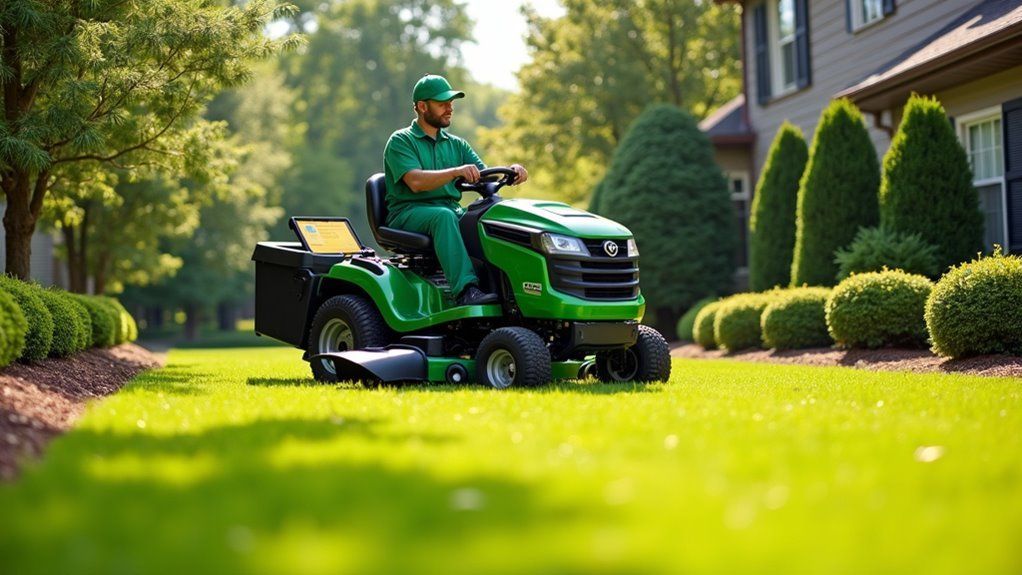
| Location Type | Average Cost (per 1/4 acre) |
|---|---|
| Urban Core | $85-105 |
| Inner Suburb | $70-90 |
| Outer Suburb | $55-75 |
| Rural Area | $45-65 |
Basic lawn mowing services cost you $45-65 per visit for lots under 8,000 square feet, with professional companies charging $50-65 and independent operators $30-45. You’ll pay 30-40% more in Northeast and West Coast regions, while the Midwest and Southeast rates remain competitive at $35-50. Annual contracts can save you 15-20%, averaging $2,400-3,600 yearly. Premium packages with extensive features range from $150 to $275 per visit. Understanding pricing factors and regional variations will help optimize your lawn care investment.
Current Market Rates for Basic Lawn Mowing Services

Based on extensive market analysis across major U.S. metropolitan areas, basic lawn mowing services currently range from $45 to $65 per visit for standard residential lots under 8,000 square feet.
You’ll find that companies using professional-grade mowing equipment typically charge on the higher end, around $50-65, while independent operators often price their services between $30-45. Service reviews indicate that higher-priced providers generally deliver more consistent results and offer add-on services like edging and cleanup.
Pricing variables include lot accessibility, terrain type, and grass height. If your property has slopes steeper than 15 degrees or requires specialized equipment, you can expect a 20-30% surcharge. Weekly maintenance contracts often provide the best value, with companies offering 10-15% discounts for regular scheduling.
Factors Affecting Lawn Care Pricing in 2025
Your lawn care costs in 2025 will primarily depend on your property’s size and location, with urban areas commanding premium rates due to higher operational expenses. You’ll find that service type selection, whether basic mowing or extensive maintenance packages, directly impacts your total investment. The frequency of service visits you choose will affect your pricing tier, with weekly maintenance typically offering the most cost-effective rates per visit compared to biweekly or monthly options.

Service Type and Frequency
Service frequency and package selections create substantial price variations in the 2025 lawn care market. You’ll find basic weekly mowing services starting at $45 per visit, while extensive maintenance packages can exceed $200 weekly. Monthly service contracts typically offer 10-15% savings compared to per-visit rates.
Premium packages include fertilization, weed control, and seasonal cleanup, driving service quality and customer satisfaction metrics higher. You’re looking at $150-275 monthly for standard biweekly maintenance, while full-service weekly programs range from $300 to $600 monthly. Most companies now offer flexible scheduling through mobile apps, letting you adjust service frequency based on weather patterns and grass growth rates. Add-on services like aeration ($100-175) and overseeding ($200-300) remain popular seasonal options in 2025’s competitive market.
Regional Price Variations Across the United States

You’ll find dramatic differences between lawn care costs in the Northeast versus Southwest regions of the United States, with Northeast prices running 30-40% higher due to shorter growing seasons and higher operational costs. Your location’s regional labor rates play an essential role in determining lawn care expenses, as areas with higher costs of living typically command premium service fees. If you’re in the Southwest, you’ll benefit from year-round growing seasons and lower labor costs, though drought conditions and water restrictions may add unexpected expenses to your lawn care budget.
While lawn care prices fluctuate markedly across the United States, regional factors like cost of living, climate, and market competition drive these variations. You’ll find the highest rates in the Northeast and West Coast, where basic lawn maintenance can cost 30-40% above the national average. Cities like Boston, New York, and San Francisco typically charge $65-85 per visit for a standard quarter-acre lot.
The Midwest and Southeast offer more competitive rates, with service costs ranging from $35-50 per visit. Regional pricing in these areas remains lower due to extended growing seasons and higher service provider density. When making service comparisons, you’ll notice that Southern states often require more frequent visits due to longer growing seasons, while Northern regions concentrate services during shorter seasonal windows.
Premium Lawn Care Package Costs
Premium lawn care packages in 2025 will command considerably higher prices than basic maintenance services, typically ranging from $150 to $275 per visit. These extensive packages include premium features that improve your property’s overall health and aesthetic appeal.
You’ll find service customization options that align with your specific outdoor needs:
- Advanced soil treatments with organic amendments and specialized fertilizers ($75-100 supplement)
- Precision tree and shrub care, including deep root fertilization and targeted pest management ($85-125 add-on)
- Seasonal color rotation with premium flower varieties and professional outdoor design consultation ($90-150 extra)
When selecting a premium package, you’re investing in specialized expertise and high-end materials. Most companies offer quarterly or annual contracts, providing cost savings of 15-20% compared to individual service bookings.
Seasonal Service Plans and Annual Contracts

You’ll save 15-20% on average by choosing annual lawn care contracts over month-to-month services in 2025, with top providers offering supplementary 5-10% early payment discounts for full prepayment. Most annual contracts include 25-30 scheduled visits, while monthly plans typically require separate agreements for each growing season at higher per-visit rates. Your commitment to longer service terms (12-24 months) opens premium benefits like priority scheduling, free service calls, and seasonal extras that aren’t available with short-term arrangements.
Monthly Vs Annual Pricing
Homeowners face a critical decision between monthly service payments and annual lawn care contracts when evaluating costs for 2025. When comparing pricing models, you’ll find that annual commitments typically offer 15-20% savings over monthly rates but require larger upfront payments.
- Annual contracts average $2,400-3,600 for all-encompassing care, breaking down to $200-300 monthly when prepaid
- Monthly service plans range from $250 to $350 per month without commitment, totaling $3,000-4,200 yearly
- Seasonal payment options fall between these extremes, offering quarterly payments with moderate monthly savings
Your choice should factor in cash flow preferences and service consistency needs. While monthly payments provide flexibility, annual contracts lock in rates and guarantee priority scheduling during peak seasons. Consider your property’s specific requirements and budget constraints when selecting between these pricing structures.
Contract Length Benefits
Contract length decisions impact both service quality and financial outcomes in 2025’s lawn care market. When you commit to longer service agreements, you’ll typically secure 15-25% cost savings compared to month-to-month arrangements. Annual contracts now average $2,800, while seasonal plans range from $1,400 to $1,800.
Your contract flexibility options have expanded in 2025, with 68% of providers offering customizable service intervals. By choosing a 12-month commitment, you’ll lock in priority scheduling and rate protection against seasonal price fluctuations. Customer loyalty programs tied to longer contracts deliver supplementary value, including free service upgrades and priority response times. Data shows that homeowners with annual contracts report 30% higher satisfaction rates and receive consistent, well-timed maintenance throughout the year.
Early Payment Discounts
Smart budgeting in 2025’s lawn care market starts with early payment advantages. You’ll find significant savings when you utilize early payment incentives, with many companies offering customer loyalty rewards for upfront seasonal or annual commitments.
- Prepay your annual contract to receive 15-20% off standard service rates, translating to an average savings of $425 for all-inclusive lawn care packages
- Choose seasonal pre-payment options to access 10-12% discounts while maintaining quarterly payment flexibility
- Combine early payment with customer loyalty rewards to enhance savings up to 25% on premium services
Industry data shows that 72% of lawn care providers now offer structured discount programs for early payment commitments. By analyzing your service needs and available payment options, you’ll refine your lawn care budget while securing premium maintenance slots
throughout the year.
Additional Services and Their Price Points
Professional lawn care providers typically offer an array of supplemental services beyond standard mowing and maintenance, with 2025 projections showing a 15-20% price increase from current rates. You’ll find organic treatments ranging from $85 to $150 per application, while traditional chemical treatments cost $65 to $120. Pest control services average $125-275 per treatment, depending on lot size and infestation severity.
Additional specialized services include aeration ($175-275), overseeding ($200-350), and tree/shrub care ($150-400 annually). Seasonal cleanup packages run $200-450, while hardscaping projects start at $1,500. For extensive lawn renovation, expect to pay $2,000-5,000, depending on square footage and soil conditions. These premium services often require specialized equipment and certified technicians, contributing to higher price points in urban markets.
Cost Comparison: Professional vs. DIY Lawn Maintenance
While the array of professional services offers convenience, comparing their costs against DIY approaches reveals significant financial implications for homeowners in 2025. Professional services average $2,800-$3,500 annually for standard maintenance, while DIY strategies can reduce expenses to $800-$1,200 per year.
- Equipment investment for DIY maintenance requires $1,500-$2,000 upfront, but these tools last 3-5 years with proper care
- Cost-saving techniques like seasonal fertilization and proper mowing height management can reduce long-term expenses by 40%
- Time investment for DIY maintenance averages 4-6 hours weekly, valued at $25-35 per hour if comparing to professional rates
Your decision between professional and DIY maintenance should factor in both monetary costs and time investment, as equipment depreciation and maintenance impact total expenses.
Tips for Getting the Best Value From Lawn Care Companies
Five key strategies can improve your investment when hiring lawn care services in 2025’s competitive market. To begin, negotiate multi-season contracts to secure rates 15-20% below standard pricing. Second, bundle services like mowing, fertilization, and pest control for an average savings of $475 annually. Third, utilize customer loyalty programs, which typically offer 5-10% cashback or service credits after your initial year.
Fourth, schedule services during off-peak months (March and October) when companies often discount rates by 25-30%. At last, request detailed service breakdowns and compare them across three providers minimum. Companies offering transparent pricing structures typically deliver 22% better value than those with package-only options. Your careful analysis of these factors will optimize service quality while minimizing costs in today’s $98.5 billion lawn care industry.
Frequently Asked Questions
Are Lawn Care Companies Required to Be Licensed and Insured?
You’ll find that licensing requirements for lawn care companies vary by state and municipality. Most areas require a business license, and if you’re using pesticides, you’ll need specific chemical application permits. Insurance coverage is typically mandatory, including general liability insurance (protecting against property damage and injuries) and workers’ compensation if you have employees. It’s essential to check your local regulations, as operating without proper licensing and insurance can result in significant fines.
What Happens if Equipment Damages My Property During Lawn Service?
If a lawn service provider damages your property, you should immediately document the damage with photos and notify the company. Reputable companies carry liability coverage specifically for these incidents. You’ll need to file damage claims through their insurance provider, which typically covers repairs or replacement costs. That’s why it’s essential to only work with insured companies; their coverage protects both you and their business from costly property damage expenses.
Can I Change or Cancel Scheduled Lawn Services Without Penalties?
Most lawn care companies offer service flexibility, but cancellation policies vary by provider. You’ll typically need to give 24-48 hours’ notice to modify or cancel a scheduled service without penalties. Many companies allow online scheduling changes through their customer portals. For long-term contracts, you might face early termination fees, usually 10-20% of the remaining contract value. It’s best to review your service agreement carefully and understand the specific cancellation terms before signing.
Do Lawn Care Companies Offer Emergency or Same-Day Service?
You’re in luck! Many lawn care companies do offer emergency services and same-day availability, though you’ll typically pay a premium of 25-40% above standard rates. While most providers require 24-48 hours’ notice, you can find companies that’ll respond to urgent situations like fallen trees, storm damage, or last-minute event preparation. It’s best to contact multiple services early in the day, as same-day slots fill quickly and may cost more during peak seasons.
How Early in the Morning Do Lawn Care Companies Start Work?
Most lawn care companies start their work hours between 7:00 AM and 8:00 AM, though you’ll find some begin as early as 6:00 AM during peak summer months. Your location’s noise ordinances typically regulate early morning start times. Professional crews prefer these early starts to optimize daylight hours and avoid afternoon heat. If you’re concerned about timing, you can request a specific time slot when scheduling, though early morning slots are often premium-priced.
Northeast vs. Southwest Costs
Significant price variations for lawn care services exist between the Northeast and Southwest regions of the United States, with Northeastern homeowners typically paying 30-40% more than their Southwestern counterparts. You’ll find that in 2025, the average lawn care cost in the Northeast ranges from $75 to $95 per visit, while Southwest prices hover between $55 - $65.
These regional differences stem from distinct lawn care trends and operational challenges. The northeast climate demands more frequent mowing during peak growing seasons and specialized equipment for leaf removal and snow management services. Meanwhile, Southwestern properties often require less intensive maintenance due to drought-resistant landscaping and xeriscaping practices. Labor costs also play an essential role. Northeast service providers face higher overhead expenses, insurance rates, and seasonal workforce demands, which directly impact your service costs.
Regional Labor Rate Impact
The national terrain of labor rates dramatically shapes lawn care pricing across different regions in 2025. You’ll find significant regional labor variations, with West Coast providers charging up to 35% more than their Midwest counterparts due to higher living costs and state-mandated minimum wages.
In metropolitan areas like Seattle, San Francisco, and New York City, you’re looking at premium rates of $75-95 per hour for basic lawn maintenance. Meanwhile, in states like Kansas, Missouri, and Oklahoma, you’ll typically pay $45-65 per hour for the same services. These pricing disparities reflect local economic conditions, competition levels, and workforce availability. Understanding your region’s standard rates helps you better evaluate service quotes and negotiate fair prices with lawn care professionals.
Additional Services and Their Cost Impact
While basic lawn maintenance forms the foundation of yard care, specialized services can substantially increase your annual landscaping costs in 2025. You’ll find that organic treatments and pest control services often top the list of supplementary expenses, reflecting growing demand for eco-friendly solutions.
Service | Extra Cost
- Organic Fertilization | $75-125 per application
- Pest Management | $200-350 per treatment
- Aeration & Overseeding | $250-400 per service
- Tree & Shrub Care | $150-275 per visit
These premium services, while initially more expensive than traditional chemical treatments, can provide long-term benefits to your lawn’s health. When budgeting for thorough lawn care, you’ll need to factor in at least 30% above your base maintenance costs to accommodate these specialized treatments throughout the growing season.
Seasonal vs. Year-Round Service Price Differences

Understanding seasonal versus year-round pricing structures helps you improve value when planning your lawn care budget. In 2025, you’ll find significant cost variations between seasonal services and year-round services, with annual contracts typically offering 15-20% savings over pay-per-visit arrangements.
- Year-round service packages average $2,800-$3,500 annually, including winter maintenance and priority scheduling
- Seasonal services cost $1,200-$1,800 for spring-fall coverage, but exclude off-season lawn protection
- Monthly payment plans for year-round contracts reduce upfront costs, averaging $235-$290 per month
- Peak season (April-September) rates run 20-30% higher than off-season pricing for individual services
When comparing options, consider that year-round services provide consistent care and often include complimentary treatments that would cost extra with seasonal packages.
Cost Comparison: DIY vs. Professional Lawn Care
Deciding between DIY lawn maintenance and professional services requires careful analysis of both direct costs and hidden expenses in the 2025 market. While DIY techniques can save you $800-$1,200 annually, you’ll need to factor in equipment rental costs ($150-$300 per season) and time investment (4-6 hours weekly).
Professional benefits include expert-level results and elimination of maintenance requirements for tools and supplies. Though you’ll pay $2,000-$3,500 yearly for professional care, you’re investing in specialized skill levels and precise seasonal timing. Consider that DIY approaches demand learning proper techniques, storing equipment, and managing weather-dependent schedules. Professional services offset their higher costs through efficiency, reliability, and guaranteed results. Your choice should align with your available time, desired lawn quality, and long-term cost savings goals.
Hidden Fees and Extra Charges to Watch For
Standard lawn care pricing often conceals extra charges that can greatly impact your total cost in 2025. When reviewing service agreements, you’ll need to carefully examine the fine print to identify potential hidden costs that could increase your expenses by 15-30% above the base rate.
- Fuel surcharges that fluctuate monthly based on current gas prices, typically ranging from $5to $15 per visit
- Emergency service fees for same-day or weekend requests, which can raise 50-75% to standard rates
- Supplementary charges for services like leaf removal, weed control, or pest treatment that aren’t included in basic maintenance packages
- Equipment fees for specialised tools or machinery needed for specific lawn conditions, often $25-50 per use
Always request a detailed breakdown of all potential charges before signing any service agreements to avoid unexpected costs.
Tips for Getting the Best Value in Professional Lawn Care
While professional lawn care prices continue to rise in 2025, you’ll find significant savings by implementing strategic approaches to service selection and scheduling. Start by comparing service contracts from multiple providers, focusing on companies with positive customer reviews and transparent pricing models.
Book your services during off-peak seasons when providers offer competitive rates. Consider bundling services like mowing, fertilization, and pest control for package discounts. Many companies now offer loyalty programs and early booking incentives that can reduce your annual costs by 15-25%.
Sign up for annual maintenance plans rather than one-off services, as they typically come with better rates and priority scheduling. Don’t forget to negotiate pricing –many providers will match or beat competitors’ quotes to secure your business.
Frequently Asked Questions
Are Lawn Care Services Covered by Home Insurance Policies?
You might be surprised to learn that your standard home insurance typically doesn’t cover routine lawn care services. While your policy may protect against sudden lawn damage from covered perils like vandalism or fallen trees, it won’t pay for regular maintenance. Most policy exclusions specifically state that landscaping services, mowing, and general upkeep aren’t covered. If you’re looking for lawn insurance coverage, you’ll need to investigate separate service contracts or maintenance agreements.
How Long Does It Take for Newly Planted Grass to Establish?
You’ll see your newly planted grass establish in different time frames depending on the seed type and ideal planting conditions. Cool-season grasses like Kentucky bluegrass typically take 5-7 days to germinate and 6-8 weeks to fully establish. Warm-season varieties like Bermuda may need 10-30 days to germinate. For the best grass growth timeline, plant during your region’s prime growing season and maintain consistent soil moisture and temperature for best results.
Can Professional Lawn Care Companies Handle Pest-Infested Trees and Shrubs?
Don’t let those pesky insects destroy your beloved environment! Yes, professional lawn care companies can effectively handle pest-infested trees and shrubs through thorough pest management solutions. They’ll assess your tree health, identify specific infestations, and implement targeted treatments using EPA-approved products. You’ll benefit from their certified arborists and technicians who can spot early warning signs, prevent spread to healthy plants, and maintain ongoing protection through scheduled monitoring and preventive care programs.
Do Lawn Care Professionals Work During Light Rain Conditions?
Most lawn care professionals will continue working during light rain, but they’ll adjust their services based on weather conditions. You can expect them to handle rainy-day operations like trimming, leaf removal, and some maintenance tasks. However, they’ll avoid mowing wet grass, as it can damage your lawn and equipment. Safety concerns and lawn maintenance challenges may lead them to reschedule if there’s heavy rain, lightning, or if the ground becomes too saturated.
What Certifications Should I Look for When Hiring a Lawn Care Company?
When hiring a lawn care company, you’ll want to look for key certification types that demonstrate expertise and professionalism. Seek providers with state pesticide applicator licenses, NALP (National Association of Outdoor Space Professionals) certifications, and ISA (International Society of Arboriculture) credentials. Following smart hiring guidelines, you should also verify they have liability insurance and workers’ compensation coverage. Supplementary certifications in sustainable practices or organic lawn care can indicate a company’s commitment to environmental stewardship.
